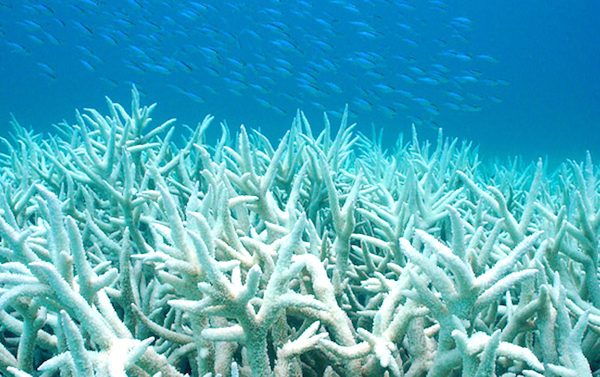Global Coral Bleaching Event Worsens; NOAA Predicts Three More Years

The Global coral bleaching event is expected to continue for its third year, lasting at least until the end of 2016, according to the National Oceanic and Atmospheric Administration (NOAA).
The announcement comes after the most powerful El Nino on record heated the world’s oceans to never-before-seen levels, huge swaths of once vibrant coral reefs that were teeming with life are now stark white ghost towns disintegrating into the sea.
Federal officials said Monday the global coral bleaching event that began in 2014 with a super-charged El Nino is ongoing and is now the longest-lasting and largest such event ever recorded.
Related Stories: Coral Reef Die-Off On Record Announced By NOAA Scientists, Caused By Sudden Global Warming
“Coral bleaching occurs when the stresses caused by unusually warm ocean waters disrupt the relationship between corals and symbiotic algae, called zooxanthellae, which live inside coral cells and engage in photosynthesis, providing the corals with energy and food. The zooxanthellae give corals their color, but during bleaching, they are evacuated from the corals’ bodies, leading the animals to turn white.
This doesn’t immediately kill corals — it depends on the length and severity of the thermal stress. However, in many places around the globe of late, ocean temperatures have either been hot enough or hot for long enough to cause coral death — most notably in the Great Barrier Reef but also in many other tropical locations around the world.
By far the greatest threat, according to NOAA, is to reefs in Palau and the Federated States of Micronesia, which aren’t U.S. territories but are considered “freely associated” with the U.S. The agency says there is a 90 percent probability that these areas will see “widespread coral bleaching” as expected La Nina conditions set in.”
While forecasters predict a change from El Nino to La Nina conditions, much of the warm water will remain in place or shift to other regions throughout the rest of the year.
JUST IN: U.S. #CoralReefs facing warming waters, increased bleaching: https://t.co/YqCM7NEkZs @NOAACoral pic.twitter.com/YG0z18WW3R
— NOAA (@NOAA) June 20, 2016
“While La Nina conditions tend to be known for bringing cooler than average ocean temperatures to the tropical Pacific Ocean, such events can also cause warmer than average ocean waters to develop and persist in the western Pacific.
Prior to the ongoing coral bleaching event, there had only been two observed global coral bleaching episodes, and both of them were tied to an El Nino.”
Related Stories: Great Barrier Reef: Over 90% Bleached Due To Climate Change
All of the reef areas in the northern hemisphere — which includes almost all of the reefs in the United States — will experience another season of bleaching, said Mark Eakin, coordinator for NOAA’s Coral Reef Watch program. Eakin noted that places like Hawaii and Florida have already had two consecutive years of severe bleaching, and a third is reason for concern.
“It’s not likely to be as severe as last year according to the models, but time will tell,” said Eakin. “It’s very important for the managers to be ready for the fact that this may be a third year of bleaching.”
Consecutive years of the global coral bleaching event have led to some of the most widespread mortality of reefs on record, leaving scientists in a race to save them. While bleached coral often recovers, multiple years weakens the organisms and increases the risk of death.
 By:
By: 